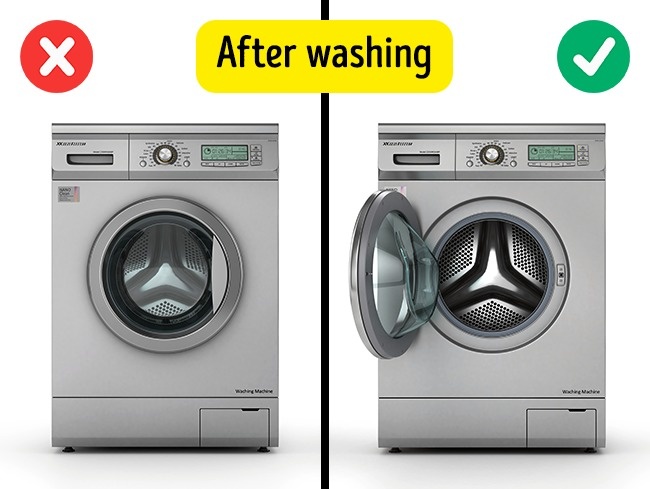It would seem that nothing could be easier than doing the laundry with a washing machine. However, even this trivial chore has a lot more subtleties than you could imagine.
Here is a list of common washing mistakes that reduce the durability of our clothes.
1. Overly high water temperature

Clothes will keep their shape and color better and wear out slower if you wash them at lower temperatures. Besides, warm or cool water can cope with dirt just as well as hot water if you have a good washing machine and detergent. Only things like linen or towels can be washed at 190°F for disinfection. All the rest can make do with lower temperatures.
2. Loading the machine with heavily stained clothes
Heavily soiled items should be presoaked, and stained clothes should be carefully washed by hand or treated with a stain remover before putting them into the washing machine. Otherwise, the dirt might not come off properly.
Instead of a stain remover, you can use alternative means. Lemon juice is a good cleansing agent for sweat stains; a mixture of vinegar and liquid detergent can remove traces of grass; wine stains will vanish after applying a mixture of water and baking soda in a 3:1 ratio.
3. Too much detergent or softener

A surplus of detergent can clog the detergent container and cause an unpleasant smell, and too much softener makes clothes less easy to rinse. Carefully read the dosages indicated on the packaging, and don’t forget to use the measuring cup. If your things are really filthy, use the pre-wash mode or run 2 cycles.
4. Using softener for all types of clothes
Besides making the fabric more velvety, linen softener facilitates ironing. However, it also reduces fabric absorbency over time, so you’d better not use it for washing towels, sportswear, or other items made from microfiber, elastane, or spandex.
5. Machine washing lingerie

With automatic washing, bras quickly stretch and lose their shape, so it’s best to wash them by hand. The same applies to lace lingerie and swimsuits.
Conversely, nylon tights can be washed in the machine if several simple rules are followed:
Use a special detergent for delicate washing.
Wash at 90°F and at a low speed.
Put the tights into a special washing bag.
Turn the tights inside out.
6. Using bleach for elastane, lycra, or spandex
Bleach with chloride is a rather aggressive agent that weakens fibers, so it shouldn’t be overused with any materials. This is especially true for elastane, lycra, and spandex, which will quickly lose elasticity if washed with bleach. Here are some more tips on how to take care of these things:
Wash them only in cool water.
Don’t use fabric softener.
Don’t dry them in an automatic dryer.
Don’t iron them.
7. Washing denim too frequently

Denim producers have a radical opinion on this point: they advise giving up machine washing altogether in order to preserve the color for longer. If you’re not ready to follow this recommendation, the optimal interval between 2 washes is a period of 2 to 6 months depending on how often you wear your jeans and on the individual characteristics of your body.
8. Drying it wrong
Incorrect drying affects your clothes as adversely as incorrect washing. Here are some tips that’ll help you avoid mistakes:
Don’t use automatic drying too often: it makes your things wear out and lose color faster. Don’t use it to dry thin and delicate fabrics.
Don’t overdry the laundry — it makes it harder to iron.
Don’t hang knitted and woolen items as they’ll lose their shape. Spread them out on a towel on a horizontal surface.
Before hanging the laundry, shake it up to prevent rumpling and creasing.
9. Bad washing machine care

Dirt, residue from detergent, and everything that accumulates inside a washing machine over time will get onto your clothes sooner or later, leading to bad smells and white stains. To prevent this, follow a few simple maintenance rules:
Air the machine out after every washing.
Remove the residual detergent from the rubber gasket on the door after every washing.
Rinse the detergent container regularly.
About once a month, run an empty machine with detergent and vinegar for disinfection.













